This sourdough discard sandwich bread recipe is perfect for sandwiches and has that classic subtle sourdough tang while only taking a few hours to whip up rather than a day. A soft crust with a fluffy interior, this is the best and easiest recipe.
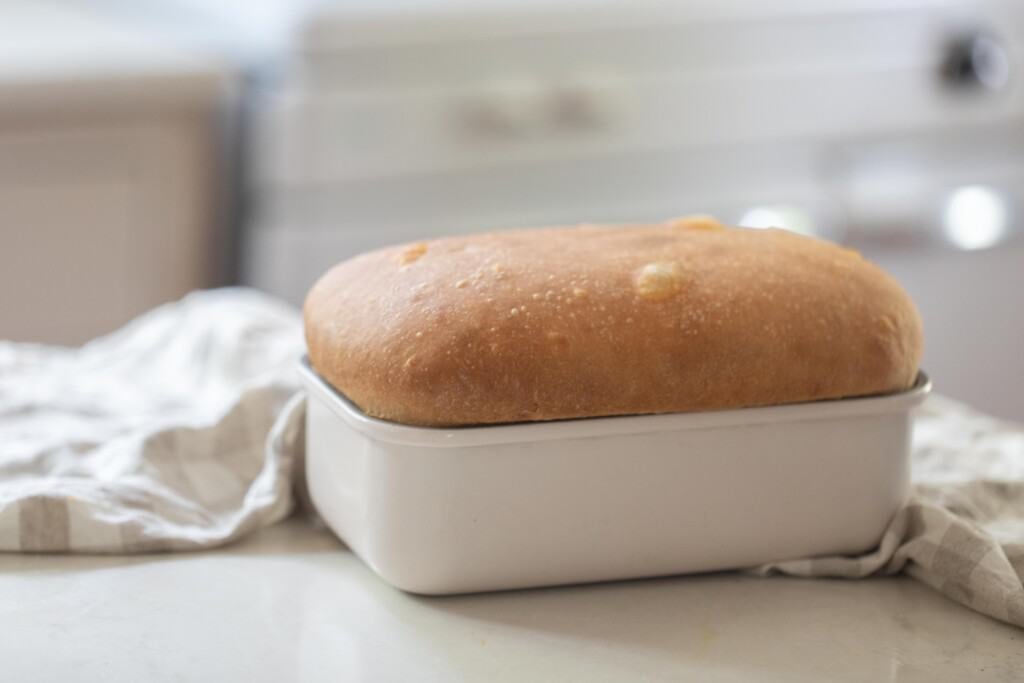
Sometimes you just need a loaf of homemade bread within a few hours.
Say company is coming over, or you didn’t plan dinner or lunch very well and realize you need some bread for sandwiches. Or maybe you are just getting into sourdough bread making and your starter isn’t mature enough to make bread just yet…
Well this discard sourdough sandwich bread is perfect for that. It uses commercial yeast to give it rise rather than relying on the natural yeast from the sourdough starter. But the sourdough starter still gives it a slight tang.
Is that slightly cheating? Maybe, but sometimes we just need something a little quicker and easier. Plus, there is just no comparing homemade to store-bought bread.
It is soft, buttery, and fluffy with a closed crumb. Perfect for sandwiches, french toast, toast, grilled cheese, bread pudding, and more.
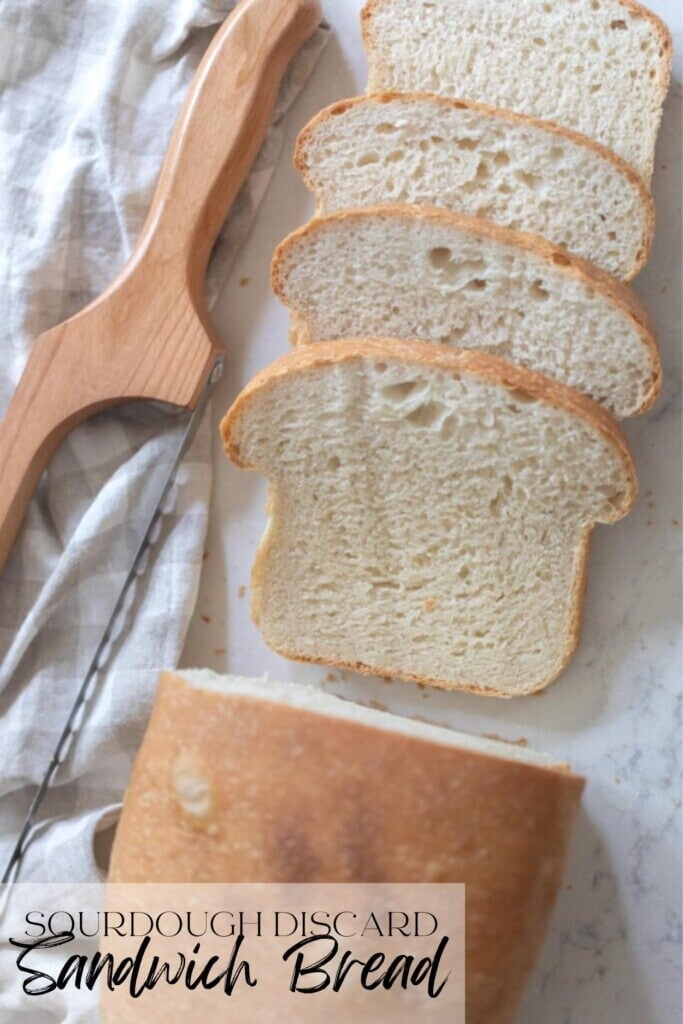
Why you will love this recipe:
Easy recipe: This recipe takes very little hands-on time. After activating the yeasts, you just throw all the ingredients into a stand mixer and let it work its magic.
Quicker: Similar to my soft sourdough sandwich bread recipe, but much less time. Yeast breads just don’t take nearly as long as a sourdough loaf.
Great way to use sourdough starter discard: If you have a new starter and are discarding and feeding a lot, this is a great way to use up that extra discard.
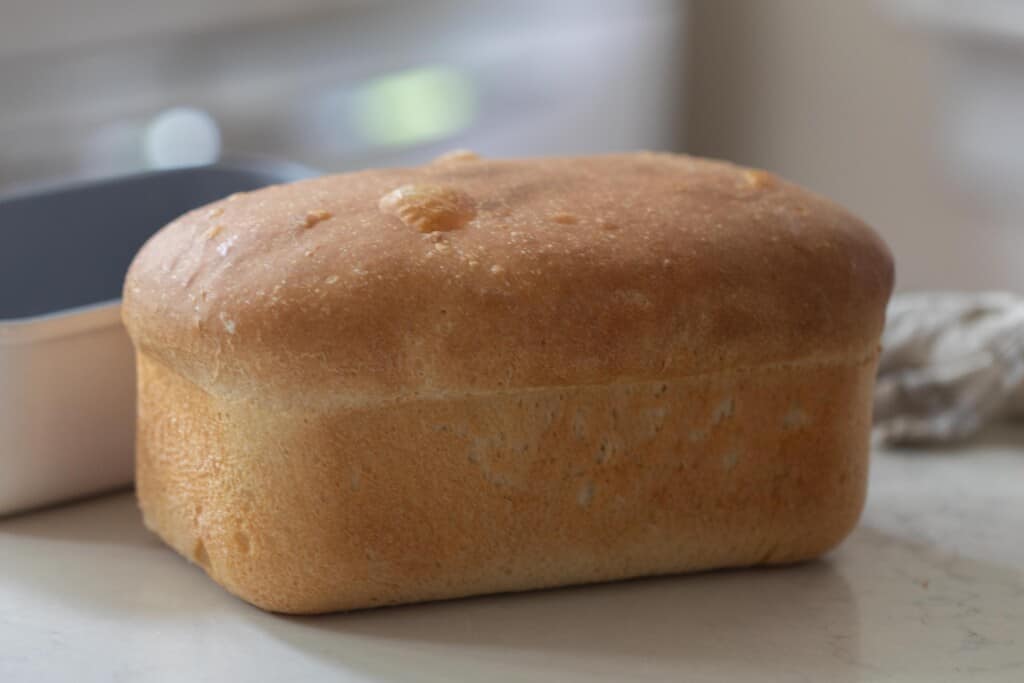
Tips:
- Use really soft butter so it will combine with the rest of the dough ingredients really well and without chunks.
- Don’t let the dough over ferment. It will turn into a wet sloppy disaster that won’t rise well.
- When making the dough, using a stand mixer makes the process much easier and hands off. You can also do this with your hands.
- If you have a Professional KitchenAid stand mixer you can double this recipe. If you have a standard mixer, I would not recommend doubling.
- If you are new to sourdough, you can check out how to make a sourdough starter here.
This post contains affiliate links, which means I make a small commission at no extra cost to you. See my full disclosure here.
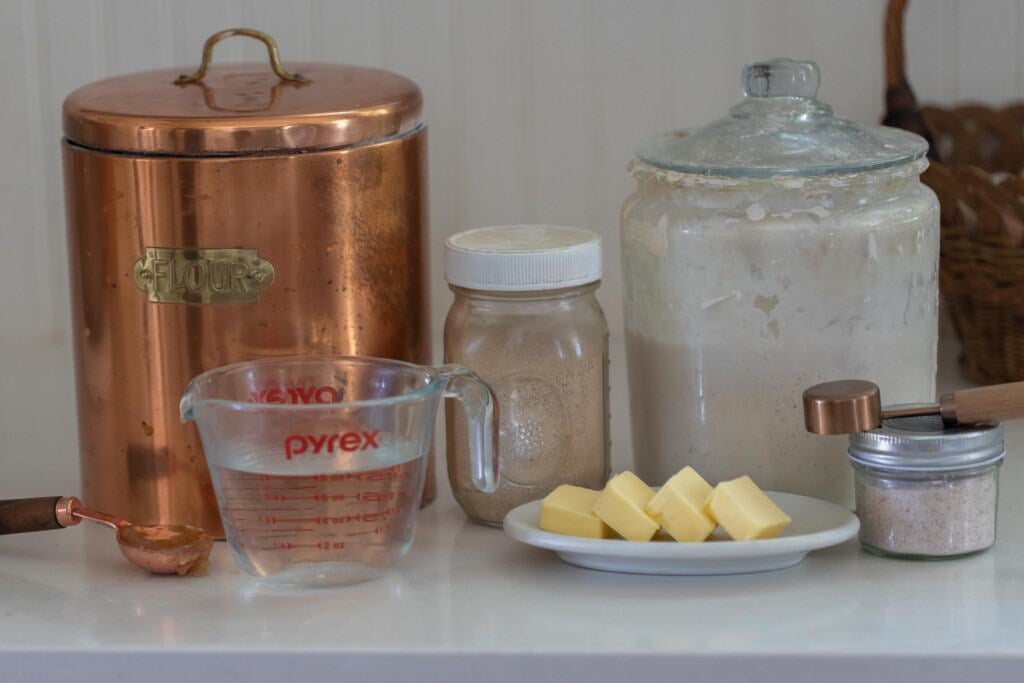
Ingredients:
Active dry yeast – The main ingredient to give this recipe rise, it doesn’t rely on the wild yeasts and bacteria in the starter to give it rise.
Butter – Softened
Honey – Could also substitute with sugar.
Salt – This gives the bread so much flavor and skipping it will leave you with a tasteless loaf.
Sourdough discard – This is a sourdough starter that hasn’t been fed in at least 12 hours. It is the portion you would typically just toss before feeding the starter. Active starter could also be used, but you will have a less tangy flavor. Find more sourdough discard recipes here.
Warm water – Room temperature. Make sure it is not too hot or you run the risk of killing the yeasts. It should be about 100 degrees F.
All-purpose flour – One of the best things about this recipe is it includes all-purpose flour, a pantry staple. If you have bread flour, that will also work.
Tools you may need:
Loaf pan
Large bowl with lid
Stand mixer with dough hook attachment
Rolling pin
Measuring cups and spoons or kitchen scale
Bench scraper: optional, but helpful.
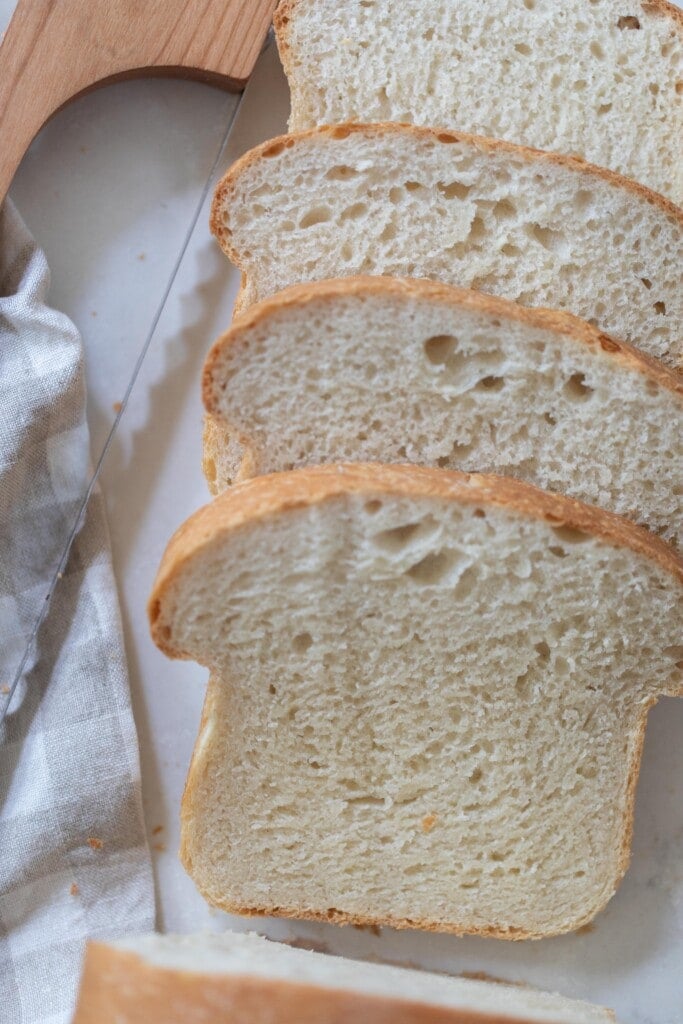
How To Make Sourdough Discard Sandwich Bread
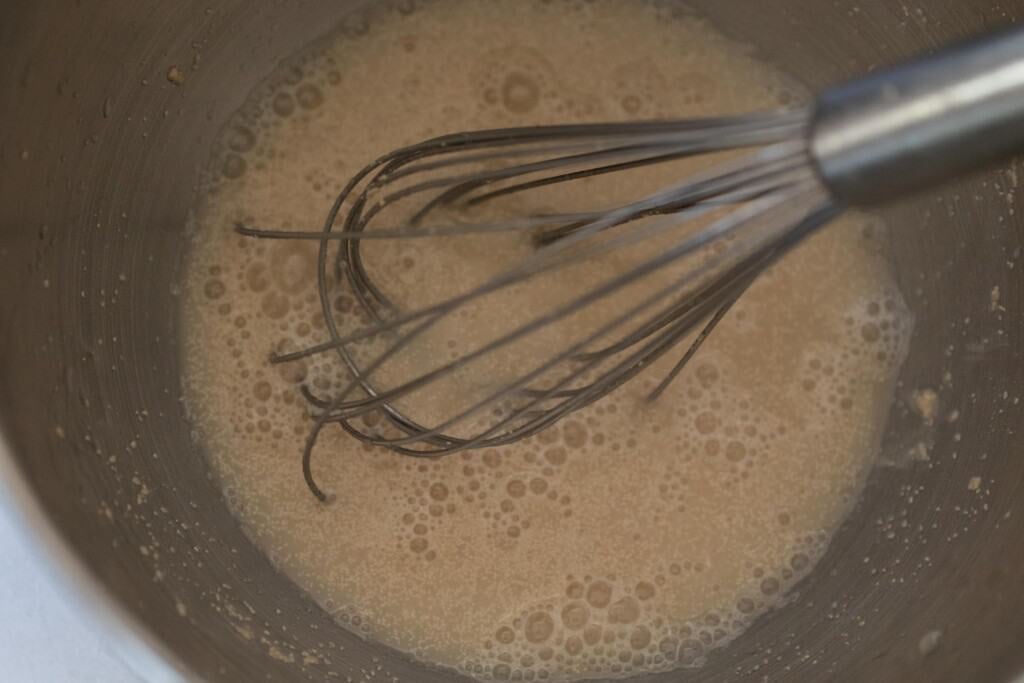
Whisk together warm water, sugar, and yeast. Allow it to sit at room temperature for about 5 minutes. The mixture should get nice and bubbly. Make sure the water isn’t too hot or it will kill the yeast.
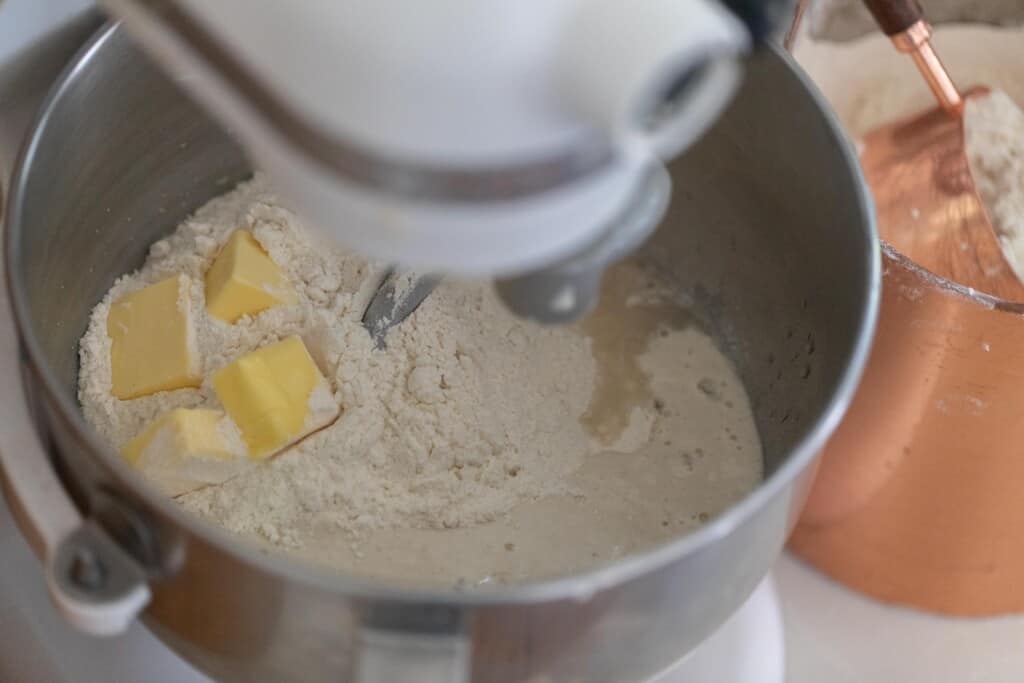
To a bowl of a stand mixer with dough hook attachment, add all of the ingredients.
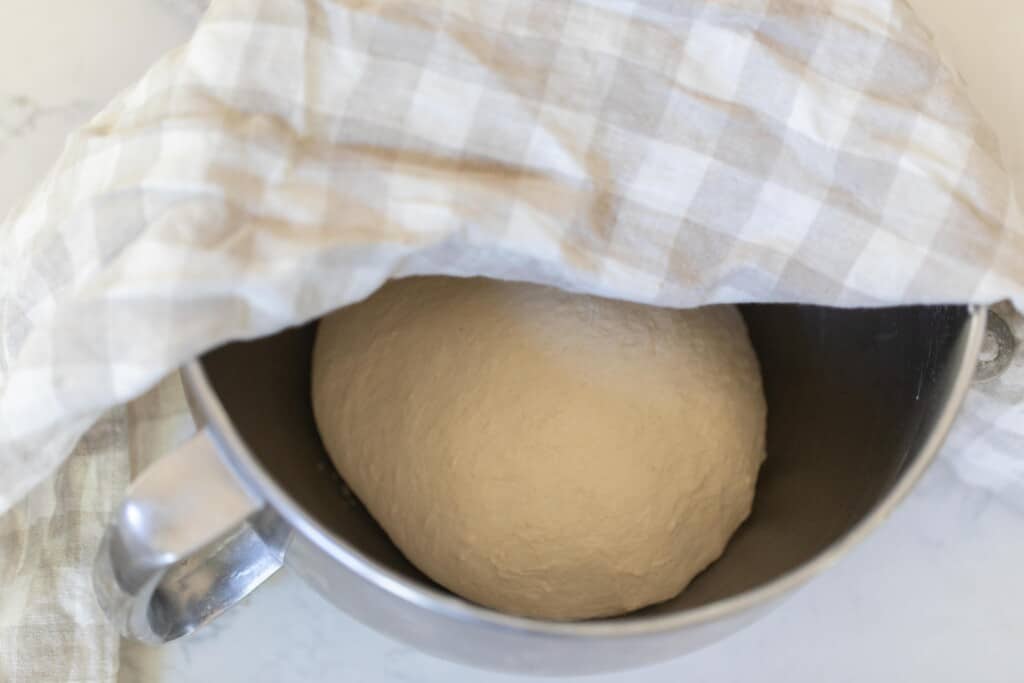
Knead on low speed until the dough is smooth and elastic – about 10 minutes or so. It may take longer. You can also do this by hand. It shouldn’t stick to the sides of the bowl.
To check to make sure the gluten has developed enough so the bread is nice and fluffy, it should pass the windowpane test. Grab a small ball of the dough and stretch it into a square. It should stretch thin enough to see through without breaking. If it breaks, it needs to be kneaded a little longer.
First Rise
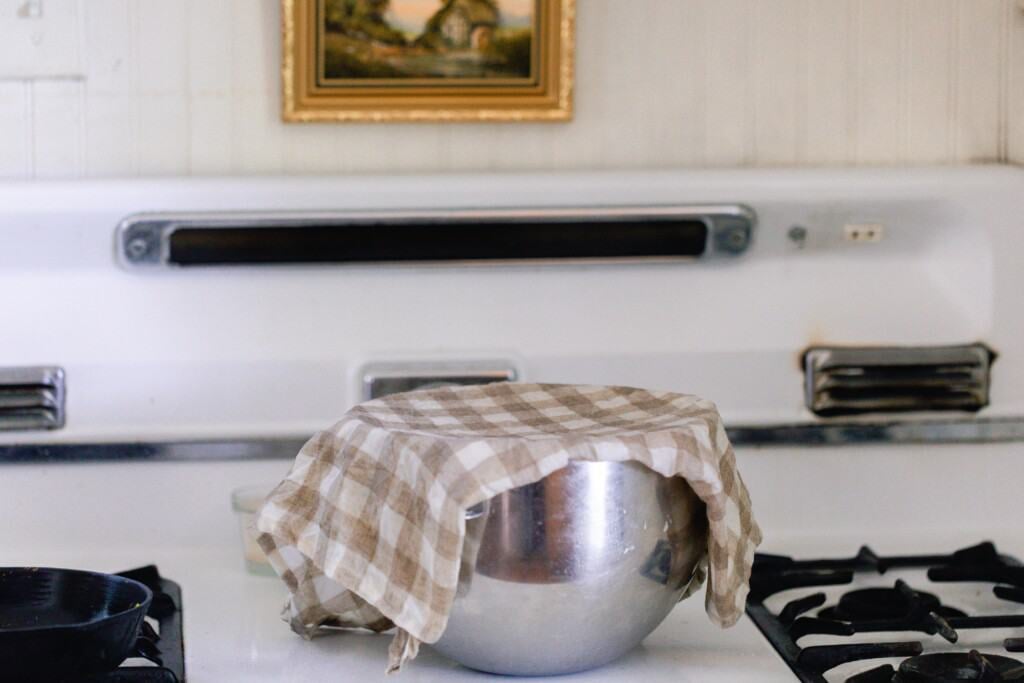
Place the dough in a greased bowl with a lid, towel, or plastic wrap.
Let the dough rise (also known as bulk rise) for about 1-2 hours (or until it about doubles in size) in a warm place like on top of a stove or on top of the refrigerator.
Shape And Rise
Grease a bread pan or add parchment paper.
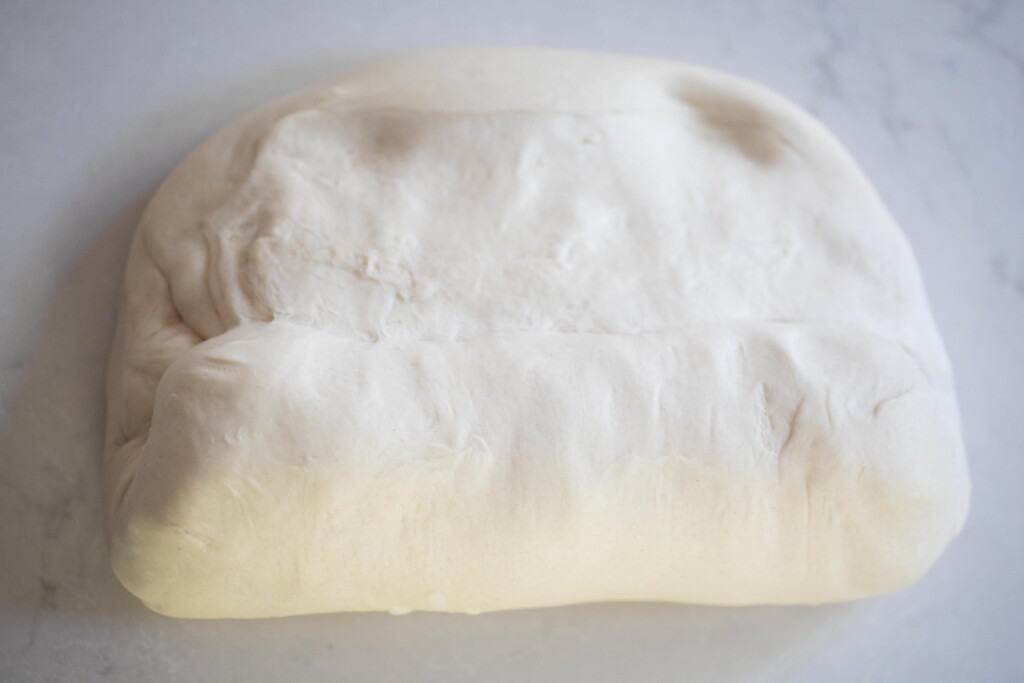
Roll the dough flat into a rectangle and roll it up. Pinch the ends to the rest of the loaf.
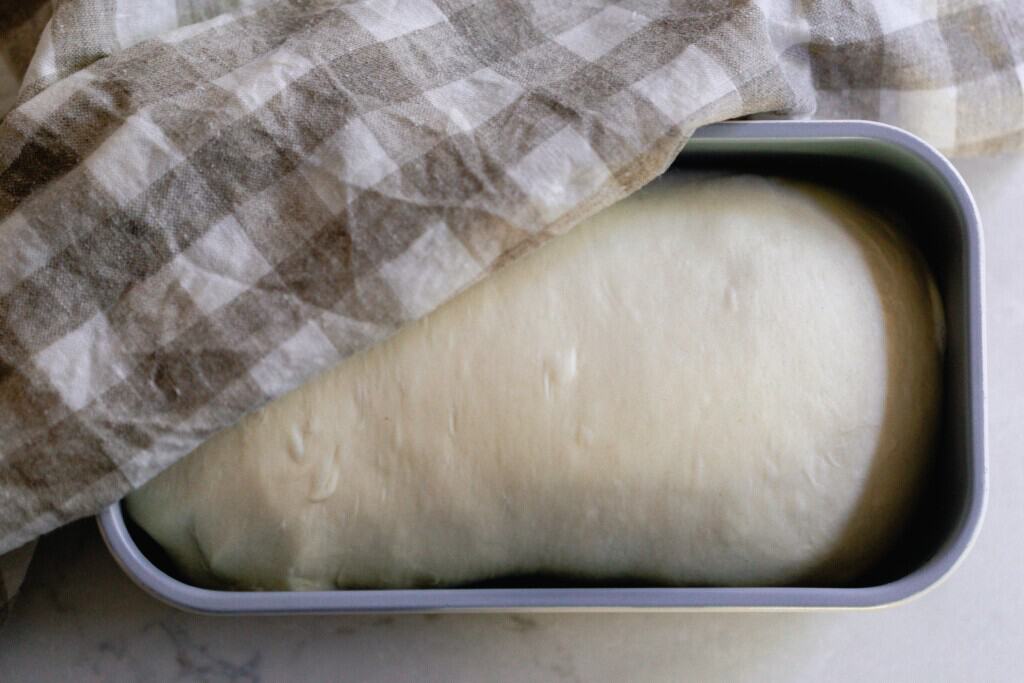
Add the shaped bread dough to the parchment lined or buttered loaf pans seam side down.
Second rise for 30 minutes to an hour at room temperature, or until doubled. Covered with a towel.
Optional: whisk an egg in a small bowl. Brush on top of the dough.
Bake the sandwich loaf at 375 for about 45 minutes, or until a lovely golden brown color on top. The internal temperature should be between 195-210 degrees F.
Allow to cool completely before slicing or storing.
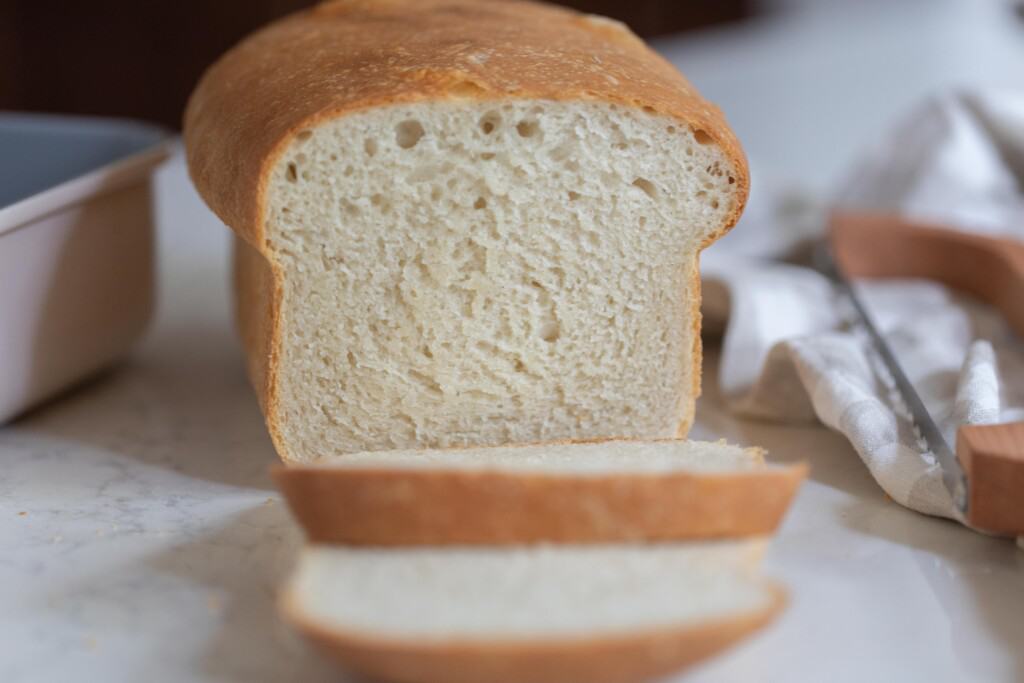
Storage:
Store in an airtight container for up to a week or freeze for up to 3 months. Check out this post all about how to store sourdough bread.
FAQ
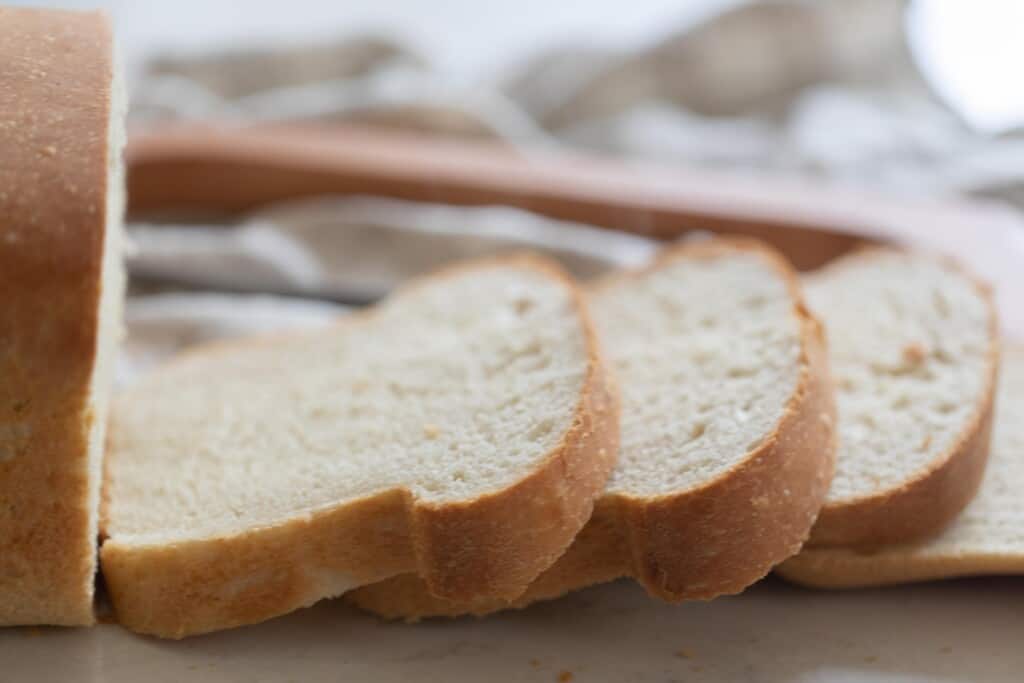
Can you do anything with sourdough starter discard?
Rather than throwing away your sourdough discard, you can use it for so many recipes. Especially recipes calling for other leaveners like yeast, baking soda and baking powder.
To learn how to make any recipe in sourdough, check out this post or for all my favorite sourdough discard recipes, check out this post.
Can you use sourdough discard in sourdough?
Yes. As long as the sourdough recipe has another type of leavener like baking soda or baking powder and doesn’t require the wild yeast in an active starter to rise the recipe (like in muffins, cookies, quick breads, cakes, etc.) then you probably can use discard.
What is the difference between sourdough bread and sourdough discard bread?
Sourdough bread relies on the wild yeast in active sourdough starter to give the bread its rise, whereas sourdough discard bread uses discard and relies on commercial yeast.
Is eating sourdough discard healthy?
Sourdough discard is healthy because the grains are already fermented and broken down. It works great in recipes, and if you add it to recipes and let it ferment, it will also ferment the grains in said recipe.
Can I use active sourdough starter for this recipe?
Yes. You can use an active starter for this recipe even though it calls for discard.
Find More Discard Sourdough Recipes:
- The Easiest Artisan Sourdough Bread
- Sourdough Discard Pretzels
- The Best Sourdough Discard Scones
- Easy Sourdough Discard Bagels
- Discard Focaccia
If you make this recipe and love it, I would love if you gave it 5 stars! Tag me on Instagram @farmhouseonboone with your delicious creation.
Sourdough Discard Sandwich Bread
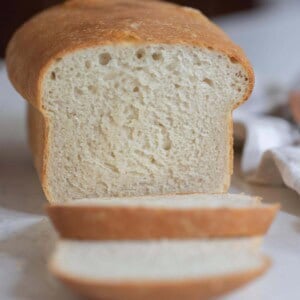
Ingredients
- 1 cup water, 236 grams
- 1 tablespoon honey, 21 grams
- 3 teaspoons active dry yeast, 9 grams
- 4 tablespons butter, softened (57 grams)
- 4 cups all purpose flour, 560 grams
- 1/2 tablespoon salt, 8 grams
- 1 cup sourdough discard, 285 grams
Instructions
- Whisk together warm water, honey, and yeast. Allow it to sit at room temperature for about 5 minutes. The mixture should get nice and bubbly.
- To a bowl of a stand mixer with dough hook attachment, add water yeast mixture, butter, flour, salt, and sourdough discard.
- Knead on low speed until dough is smooth and elastic- about 10 minutes or so. It may take longer. You can also do this by hand. It shouldn't stick to the sides of the bowl.
- To check to make sure the gluten has developed enough so the bread is nice and fluffy, it should pass the windowpane test. Grab a small ball of the dough and stretch it into a square. It should stretch thin enough to see through without breaking.
- Place the dough in a greased bowl with a lid, plastic wrap, or towel.
- Let the dough rise (also known as bulk rise) for about 1-2 hours (or until it about doubles in size) in a warm place like on top of a stove or on top of the refrigerator.
- Grease a bread pan or add parchment paper.
- Roll the dough flat into a rectangle and roll it up. Pinch the ends to the rest of the loaf.
- Add the shaped bread dough to the parchment lined or buttered loaf pans seam side down.
Second rise for 30 minutes to an hour at room temperature, or until doubled. Covered with a towel. - Optional: whisk an egg in a small bowl. Brush on top of the dough.
- Bake the sandwich loaf at 375 for about 45 minutes, or until a lovely golden brown color on top.
- Allow to cool completely before slicing or storing.
Notes
- The internal temperature of baked bread should be between 195-210 degrees F
- Use really soft butter so it will combine with the rest of the dough ingredients really well and without chunks.
- Don’t over ferment the dough. It will turn into a wet sloppy disaster that won’t rise well.
- When making the dough, using a stand mixer makes the process much easier and hands off. You can also do this with your hands.
Nutrition
Nutrition information is automatically calculated, so should only be used as an approximation.
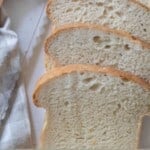
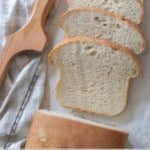
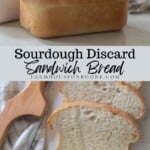




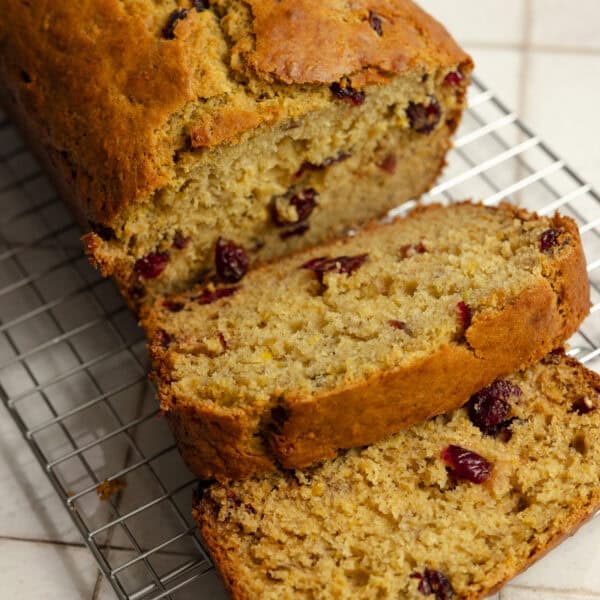

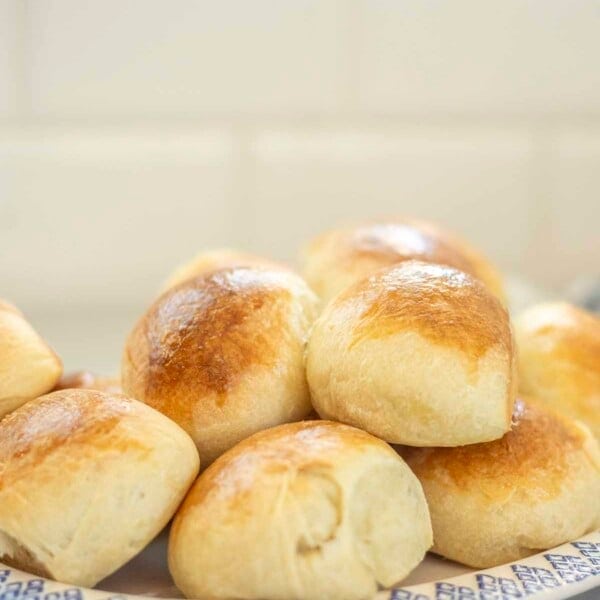






This is an excellent way to use up sourdough discard. The bread is soft and moist with a thin crust. It’s excellent both plain and toasted, and makes delicious French toast and grilled cheese sandwiches. I always use weight measures when making bread and 1 cup of 100% hydration discard weighs considerably less than 285 grams. The 9 grams of yeast seemed a bit excessive, however I followed the recipe. I held back some of the all-purpose flour, and ended up only needing 510 grams to get a soft, smooth, pillowy, tacky dough. The first rise was almost 2 hours and the second was an hour. I divided the fermented dough into an 850 gram portion for an 8×4-inch loaf pan, and two 130 gram portions for sandwich rolls. The bread had phenomenal oven rise.
Hi Sadie, how long did you bake the bread and the sandwich rolls? Did you just form the rolls on a baking sheet?
Thank you!
You need to fix the instructions in the actual recipe. It is missing the very important step to divide the dough in two before rolling and pinching. That said, I am enjoying a very large loaf right now and even though it’s HUGE, it’s tasty. I will be making this again this week.
😬😬 no don’t split ur dough – I listened to this list and now have 2 really short liaves of bread – it really food for Sammy’s in less I was 3 !!😬😬😬 keep it one loaf!!
Thank you for sharing this great recipe! I’ve tweaked it a bit to arrive at what is a perfect sandwich bread for my taste, adding five-grain cereal, swapping out some of the flour for whole wheat, and upping the amount of honey a bit to make the flavor a little more pronounced. I had similar issues to other reviewers with kneading times and oven blowout. A little extra water and added gluten helped with texture. I reduced overall quantity by about 20% and reduced yeast to 1 1/4 tsp – the resulting loaf was just right for a 9×5 loaf pan.
Is it really supposed to be a 54% hydration dough, or is that a misprint? My calculator says that 3 cups of flour would put you at about 67%, which is closer to what I’ve seen for sandwich bread. I’ve never tried dough that dry.
This is an incredibly easy recipe! My starter is only 12 days old but has good flavor. I do agree that it is a little too much for the loaf pan. Will be scaling back for it to fit the pan and sandwich bags for hubby’s lunch. Thank you Lisa!
You’re welcome!
Today was my 1st home run in my sourdough journey. This recipe is amazing! Instruction were spot on, the bread is mouth watering and my loaf looks EXACTLY like the 1 pictured! My favorite bread recipe!
That’s great news!
Mine rises soooo high! I used a 9×5. Any ideas what could have happened? This is the 3rd time I’ve used this recipe and it’s soo big lol delicious though
You can try using two loaf pans or one larger loaf pan!
Does this recipe make one or two loaves of bread? Thank you!
1 loaf!
I wondered the same since the recipe says loaf “pans”. I just pulled my single loaf out of the oven. While it split a bit on the side it smells delicious! Can’t wait to taste it!
Great news!
My crust turned out hard too – but after storing it in an airtight ziplock bag, it softened right up the next day. I think it helped to re-absorb some of the moisture.
Would I be able to to do this without yeast and just let it rise longer, or perhaps increase the amount of starter so it rises on its own?
Since this is a discard recipe, you still need something to make it rise. I would suggest using my regular sandwich bread recipe that calls for active starter if you do not want to use yeast.